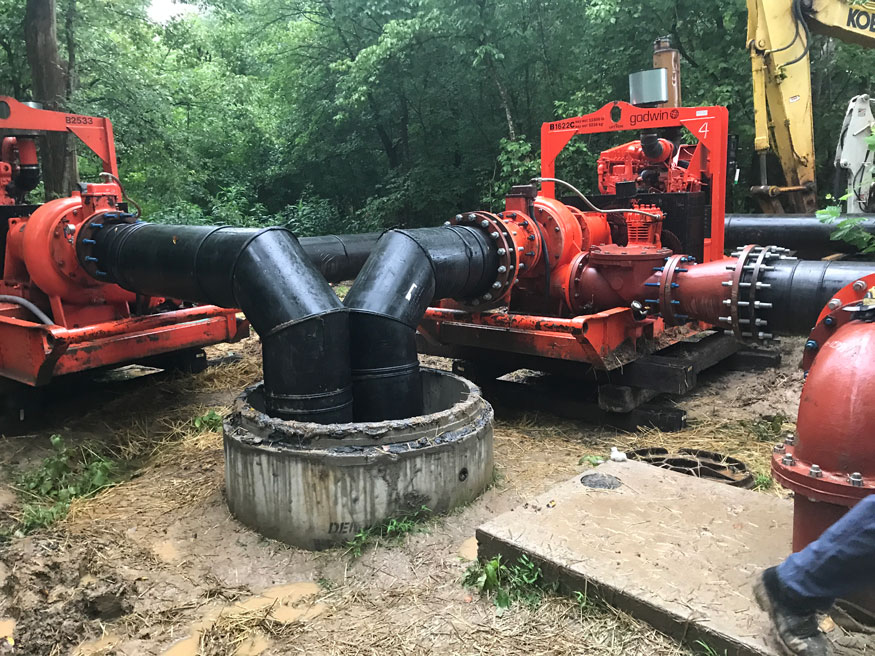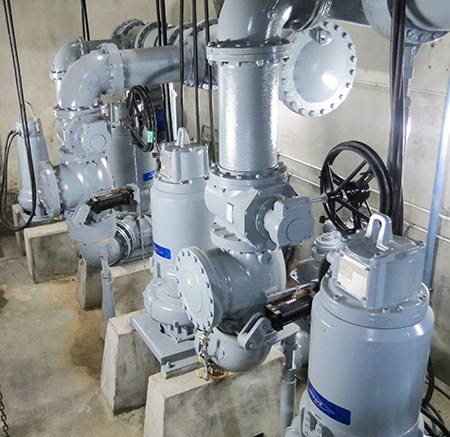
When the Turtle Park Pump Station in Oak Ridge, Tennessee, began experiencing frequent failures due to equipment age and limited means of station bypass, city officials recognized the pump station required a major overhaul. As the largest and most critical sewer pump station in the city’s wastewater system, the Turtle Park Pump Station receives all combined flows from the city’s collection system that feeds to the Turtle Park wastewater treatment plant, representing approximately 95% of all sewer flows in the city.
But by 2017, the station had become outdated, using two 40-year-old intermediate shaft-driven pumps and two direct-coupled nonsubmersible pumps located within a dry pit. The motors, electrical distribution and control systems located on the upper floor, ranging from 20 to 40 years old, had also reached the end of their useful lives and were no longer reliable.
Originally built in the late 1970s with a firm capacity of 14.1 million gallons per day (mgd), the Turtle Park Pump Station was upgraded in the late 1990s to a firm capacity of 30 mgd. In lieu of replacing the 1970s pumping equipment during those initial improvements, two 15-mgd pumps were added.
As part of the station upgrade, the city of Oak Ridge sought to replace the antiquated systems while protecting the environment from potential releases due to high flows. Equally important to the city was achieving a reduction in electricity usage and carbon footprint with new, more energy-efficient technology.
Compact Dry Well Presents Multiple Design Challenges
The design and installation phase posed several challenges for the project team. The original dry well configuration posed a major challenge, as tight clearances between the pumps made maintenance difficult. The compact dry well, which measured only 16 feet, 4 inches by 32 feet, 8 inches, also limited available pump and piping configurations despite the need to accommodate a wide range of flows, from a minimum of 1 mgd to a peak of 30 mgd. Additionally, the tight space meant a limited means of bypass pumping at the existing station. Lastly, the electrical systems needed to be replaced, all while maintaining service during construction.
The utility also expressed a desire for two tiers of pump capacity—smaller pumps to accommodate dry weather flow conditions and larger pumps for wet weather flow conditions—adding yet another challenge to the station layout.
The average daily flow requirement was 4.2 mgd with a range from 1.0 to 7.6 mgd. By providing different capacity pumps, the team could meet one of the city’s goals and provide maximum hydraulic efficiency and energy savings. The existing suction isolation valves also required replacement, which necessitated a complete station bypass. Because existing capabilities were limited to dry weather flow rates, the team needed a new approach to ensure no overflows occurred during construction.

Space Constraints
The city of Oak Ridge worked with an engineering consulting firm and a water technology provider to design a pumping solution that met the utility’s goals while overcoming the station’s legacy constrictions.
Previously, the Turtle Park Pump Station had conventional dry pit pumps with long-line shafts and motors located on different floors. The water technology provider’s solution was to provide T-installation vertical dry pit submersible pumps, which are compact and can be installed under the flood level of the station, allowing them to run even if the station floods.
To meet the station’s needs to be more flexible and efficient, the provider selected wastewater submersible pumps. Two of the smaller capacity pumps are now used during dry weather without compromising the station’s efficiency, while the three larger capacity pumps can run during wet weather and peak flow conditions.
While the use of two different pump sizes presented a challenge for the engineering firm in terms of piping design, the compact nature of the pumps allowed engineers to fit the modern, efficient design into the existing footprint. Ultimately, the project team was able to fit five new dry pit submersible pumps and associated piping in a space that had only accommodated four previously.
The weather further complicated the project, with the team executing the entire upgrade during a period of repeated heavy rainfall in one of the wettest years on record for the city of Oak Ridge. The temporary system was able to handle all incoming flows, and all bypasses were completed without overflows to the environment. This was especially important due to the location of the bypass immediately adjacent to East Fork Poplar Creek.
To replace the existing electrical switchgear while maintaining operation during construction, the installation team used a phased approach to ensure uninterrupted operation.
Peak Capacity Exceeds Expectations
The project team completed the pump station upgrades in December 2018. During the first five months of operation, the pump station realized a 7% reduction in electrical consumption despite rainfall that resulted in higher than average flows. Thus, the project realized one of the city’s goals of becoming more energy efficient. The new pumps also helped to maintain a firm capacity of 32 mgd.
“The station’s ability to deliver 30 mgd to the Turtle Park WWTP during high-flow events is crucial to the city’s efforts to reduce and eliminate overflows in the collection system,” said Tom Roberts, maintenance superintendent for the city of Oak Ridge.
Ultimately, the team achieved all of the city’s goals within the confines of the legacy station. Among the goals realized by the project were mechanical reliability, protection of the environment, reduced station noise and the elimination of the two shaft-driven pumps from the station’s main floor. This helped result in an efficient and resilient main wastewater pump station for the city of Oak Ridge and its residents.


